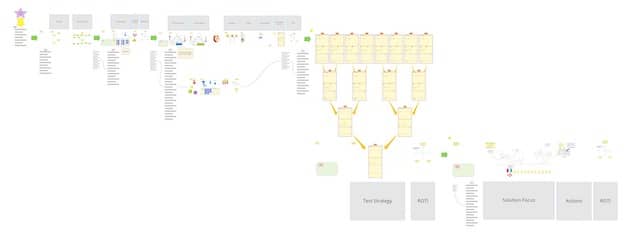How the pandemic made us discover better ways of coaching
This pandemic year has transformed the way we do technical agile coaching. It’s now more asynchronous, self-service, gamified, open, and inclusive!

I would have each share their screen and I would watch[…], flicking between screens. It was exhausting for me but otherwise worked well […]. (Avi Kessner on extremeprogramming@groups.io)
I moved one physical training session into Zoomland and the result did not thrill me. We did well enough with what we had, but I definitely did not like losing the ability to wander around the room and look over people’s shoulders to ask questions (JB Rainsberger on extremeprogramming@groups.io)
Without the travel to on-site, it seems silly to try to cram things into full days. And with the friction of remote work, seems counter-productive. I think there are better models waiting to be fleshed out. (George Dinwiddie on extremeprogramming@groups.io)
⭐️ Wouldn’t it be great if challenges always resulted in better ways of working?
I would not have bet on that when the pandemic hit us in Spring 2020.
Murex has offices in Beirut, Dublin, and Paris. We had already tried to nudge people into remote-friendly work before the pandemic. For example, we experimented remote-first Community of Practice event… But we received a lot of push-backs!
A coach teammate, Ahmad, was working from Beirut. Fortunately for us, we were already working in hybrid mode, and the transition was easy for us. When all the company started to work from home, we thought: “It’s now, it’s going to work this time!”. We launched a Remote-Work Community of Practice, but again, the audience did not stick.
Lock-down had suddenly made coaching, relying on pairing and mobbing, a lot harder! We had no idea how we were going to manage.
Yet, you know the saying:
Like everyone, we had to adapt, and we learned a ton by doing so! We had to transform our material and pedagogy. Our coaching techniques are now more remote-friendly, asynchronous, inclusive, open, and self-service! Like many, we are suffering from COVID anxiety and Zoom fatigue. Yet, some aspects of our work are now both more sustainable and effective.

One thing is sure: we will never work as before, even when we get back to the office! Here are a few examples of the changes we made:
Remote Mob Tooling
Before the pandemic, we had been using git-handover to rotate drivers in remote pairs and mobs. We relied on the watch.sh script to keep repos in sync. (Find out more in Best open source tools for remote pair programming). When all our coachees started to use this script, we had to seriously improve it.
Here are a few unexpected outcomes that came out of this:
- The script is now more portable and lets everyone mob from his preferred setup.
- We now have a git handover + TCR script! It turned out we had been experimenting with TCR when the lockdown started. It just made sense to combine the 2 scripts together!
- We are planning to open-source this script!

💡 If you struggle with remote pairing or mobbing, give watch.sh or the mob tool a try!
Reusable Remote Workshop Templates
Before the pandemic, we used to rely on everyone being present during workshops. Like every agile coach, we were using a lot of sharpies and sticky notes. Like every agile coach, we used to redesign a new workshop every time.
Everything changed when the lockdown hit us. The company was already using Miro; it felt natural to port our workshops there. It was awkward at first: small screen, clumsy manipulation… After a while, though, we started to notice some benefits:
- We were able to reuse and improve activities every time we went through a similar workshop. For example, we have built a Test Strategy workshop board that is being reused a lot at Murex.
- We replaced long workshops by successions of shorter and sustainable sessions. We discovered that remote workshops become a total waste of time when they last longer than 1h30. Inspired by Training from the Back of the Room, we now ask participants for some asynchronous homework between sessions. Many actually do them!
- With all this experience under our belt, we ran a successful remote code-retreat at DDD Europe!
We are now refining and adding facilitation instructions to our workshop templates. We are slowly getting to self-service workshops!
💡 Do you want to learn more about remote facilitation? Nick Tune wrote fantastic posts about how to create great workshops using Miro:
- Remote Workshops Using Miro: What I’ve Learned So Far
- Organising Large Miro Boards For Remote Workshops
Written communication for tech coaching
We used to stick posters on the walls to get people’s attention. I tried to do the same next to my desk at home, but no one noticed 😉.

Fortunately, I have been blogging for a long time, and it was natural to start blogging at work too. Blogging is a long-term strategy, though. Plus, intranets are not yet as inbound-marketing friendly as the internet. Yet, a few months in, people are starting to ask for help after reading our posts.
Here again, the pandemic brought unexpected benefits through our internal blogging:
- We are more visible! We are getting more inbound work. We only work with volunteer people and teams, and more inbound work means more freedom.
- As we reach more people, we can hope it will bring more change to the organization. Especially since some teams don’t want coach interference but prefer to practice by themselves.
- As I mentioned above, many Murex teams are spread over different countries. Making all communication online bridges the gap between offices. In the end, it also makes work more inclusive.
- We post self-service instructions to other activities like Miro templates or Code katas!
💡 Reading Technical Blogging is an excellent way to start blogging! (NOTE: I never followed any formal course about how to start a blog, but it would have been more effective if I had! I just began to share memo notes, and I would not recommend this as a marketing strategy!)
Video-Gamification for tech agile coaching
| We’ve been dabbling with TCR (Test && Commit | Revert) among coaches for a while. We started from Thomas’ Denifel scripts and tweaked them. |
As I wrote above, the pandemic made us merge TCR and git handover scripts into one! This made it easier to use TCR.
We’ve been using TCR for all our coach-the-coach sessions for a few months, and we love it! Lately, we’ve even started to use TCR in katas with teams, and it’s been working surprisingly well!
- People like it!
- They say it’s fun, that it’s got a poker-like flavor: “I’m betting my work on its correctness!”
- We don’t like others to point towards our mistakes. Having a script revert our failing changes is OK. Having an annoying coach repeating to take small steps all the time is just painful.
- Given the TCR success, we are exploring other ways to gamify coaching:
- Running Diego Lemos’ extreme-carpaccio workshop.
- Running Michel Grootjans’ Kanban Simulator with whole teams.
- Gamified, and especially video-gamified, activities are more self-service by design!

💡 If you haven’t already given TCR a try, I urge you to have a look at Thomas Denifel’s scripts.
💡 Don’t hesitate to ask and subscribe if you would like me to write more about any of the topics above.
Call to action
Step by step, we are turning some of our work into self-service material! Self-service material means that we can have
- More impact
- A more sustainable pace
- And more exciting work!
The constraints of the pandemic forced us into innovation. The key lesson here is that there are always better ways to work! Let’s not wait for the next pandemic! Let’s experiment with artificial constraints to trigger innovation!
💡 Are you struggling with the post-pandemic new way of doing technical agile coaching? Give the ideas above a try!
You are welcome to share any new way of doing technical agile coaching that the pandemic forced you into!
Here are a few other posts that might interest you:
- Best open source tools for remote pair programming presents our
watch.shgit-handover script and other remote pairing open source tools. - Here is How to deliver a remote training with code-katas and randori in pairs.
- 5 Years of Blogging About Software is an old post where I explained how I started blogging.
- Wondering why we only work with volunteers? Check 5 technical agile coaching tips to fight exhaustion from laggards
- A complete workshop for your team to see what’s a good test strategy






Leave a comment